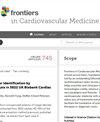Lipoprotein(a) as a novel biomarker for predicting adverse outcomes in ischemic heart failure
IF 2.8
3区 医学
Q2 CARDIAC & CARDIOVASCULAR SYSTEMS
引用次数: 0
Abstract
BackgroundLipoprotein(a) [Lp(a)] is an independent risk factor for atherosclerotic cardiovascular disease (ASCVD). However, the association between Lp(a) and adverse outcomes in patients with ischemic heart failure (IHF) remains unclear. This study aimed to investigate the relationship between serum Lp(a) levels and the incidence of major adverse cardiovascular events (MACE) in IHF patients.MethodsIn this single-center, retrospective cohort study, 1,168 IHF patients who underwent elective percutaneous coronary intervention (PCI) were enrolled. Patients were divided into four groups based on Lp(a) quartiles. The primary endpoint was MACE, defined as a composite of all-cause mortality, non-fatal myocardial infarction (MI), and any revascularization. Cox proportional hazards models were used to evaluate the association between Lp(a) quartiles and adverse outcomes. Restricted cubic spline (RCS) curve were constructed to explore the nonlinear relationship between Lp(a) levels and MACE risk. Subgroup analyses were performed to investigate the association in different subgroups.ResultsThe incidence of MACE increased significantly across Lp(a) quartiles (Quartile 4 vs. Quartile 1: 46.4% vs. 22.9%,脂蛋白(a)是预测缺血性心力衰竭不良后果的新型生物标记物
背景脂蛋白(a)[Lp(a)]是动脉粥样硬化性心血管疾病(ASCVD)的独立危险因素。然而,脂蛋白(a)与缺血性心力衰竭(IHF)患者不良预后之间的关系仍不清楚。本研究旨在探讨 IHF 患者血清脂蛋白(a)水平与主要不良心血管事件(MACE)发生率之间的关系。方法在这项单中心回顾性队列研究中,共纳入了 1,168 名接受择期经皮冠状动脉介入治疗(PCI)的 IHF 患者。根据脂蛋白(a)四分位数将患者分为四组。主要终点是MACE,定义为全因死亡率、非致死性心肌梗死(MI)和任何血运重建的综合。Cox比例危险模型用于评估脂蛋白(a)四分位数与不良结局之间的关系。构建了限制性立方样条曲线(RCS),以探讨脂蛋白(a)水平与MACE风险之间的非线性关系。结果 Lp(a)四分位数的MACE发生率显著增加(四分位数4 vs. 四分位数1:46.4% vs. 22.9%,P < 0.001)。在对混杂因素进行调整后,Lp(a)最高的组别仍与MACE风险增加独立相关(HR,95% CI:2.28,1.69-3.07,P < 0.001,趋势P <0.001)、全因死亡率(HR,95% CI:2.33,1.54-3.54,P <0.001,P for trend = 0.01)和任何血运重建(HR,95% CI:2.18,1.35-3.53,P = 0.002,P for trend = 0.001)。RCS模型显示,脂蛋白(a)水平与MACE风险之间存在非线性正相关关系。亚组分析显示,Lp(a)水平与体重指数(BMI)存在显著的交互作用,体重指数越高的患者相关性越明显(交互作用的 P 值为 0.001)。
本文章由计算机程序翻译,如有差异,请以英文原文为准。
求助全文
约1分钟内获得全文
求助全文
来源期刊

Frontiers in Cardiovascular Medicine
Medicine-Cardiology and Cardiovascular Medicine
CiteScore
3.80
自引率
11.10%
发文量
3529
审稿时长
14 weeks
期刊介绍:
Frontiers? Which frontiers? Where exactly are the frontiers of cardiovascular medicine? And who should be defining these frontiers?
At Frontiers in Cardiovascular Medicine we believe it is worth being curious to foresee and explore beyond the current frontiers. In other words, we would like, through the articles published by our community journal Frontiers in Cardiovascular Medicine, to anticipate the future of cardiovascular medicine, and thus better prevent cardiovascular disorders and improve therapeutic options and outcomes of our patients.
文献相关原料
| 公司名称 | 产品信息 | 采购帮参考价格 |
|---|
 求助内容:
求助内容: 应助结果提醒方式:
应助结果提醒方式:


